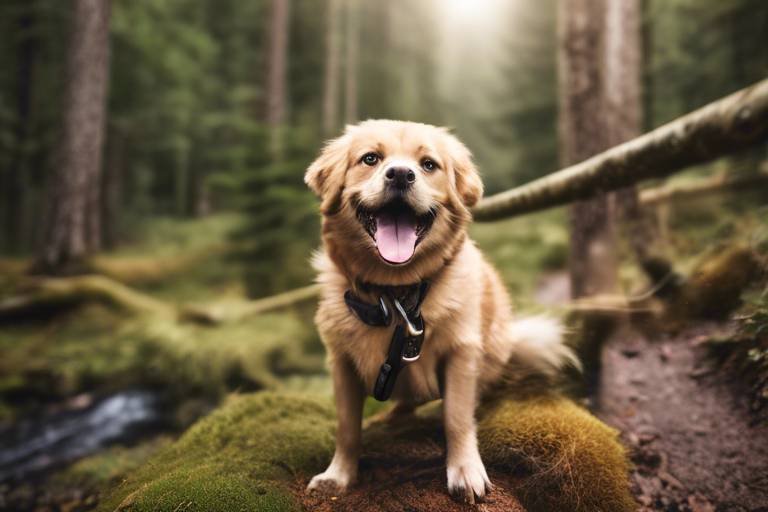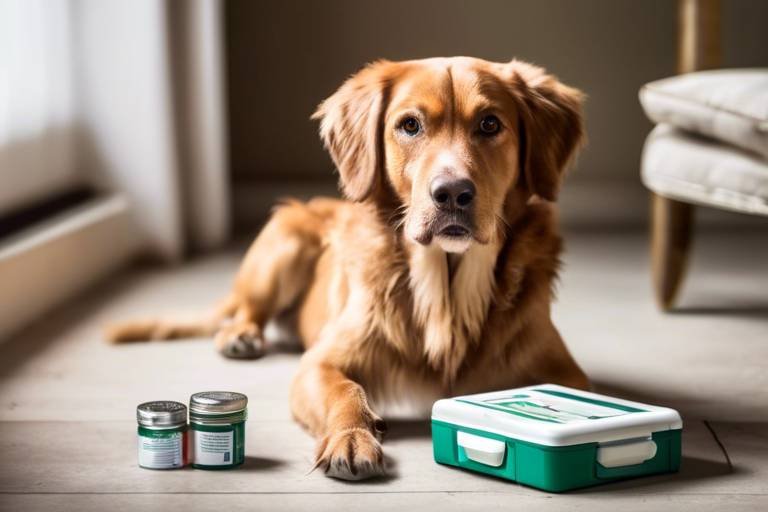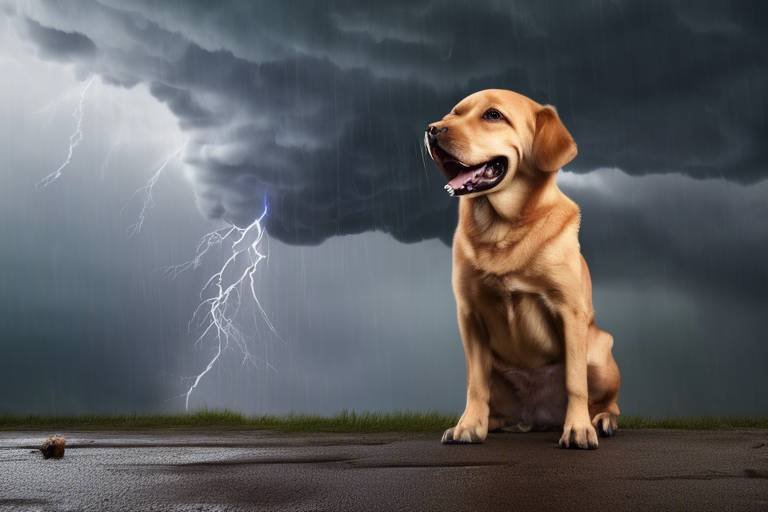How to Keep Your Pet Safe During Outdoor Adventures
Outdoor adventures can be an exhilarating experience for both you and your furry companion. Whether it's a hike through the woods, a stroll on the beach, or simply a day at the park, the great outdoors offers a multitude of opportunities for bonding and fun. However, with all that excitement comes the responsibility of ensuring your pet's safety and well-being. In this article, we will delve into essential tips and strategies to keep your pet safe while enjoying outdoor activities. From preparation and choosing the right gear to recognizing your pet's limits and being prepared for emergencies, we've got you covered. So, let’s embark on this journey to ensure a worry-free adventure for you and your beloved pet!
Proper preparation is vital for any outdoor adventure with your pet. Before you even think about stepping out the door, there are several key steps you should take to ensure a smooth and enjoyable experience. First and foremost, consider your destination. Research the area to understand its terrain, weather conditions, and any potential hazards. Are there any pet-friendly trails or parks? Knowing where you’re going can help you pack appropriately.
Next, make sure your pet is up-to-date on vaccinations and flea/tick preventatives. A trip to the vet for a check-up can also help identify any health issues that might arise during your adventure. Additionally, pack a bag with all the essentials: water, food, a leash, waste bags, and a first aid kit. Having everything ready will save you time and stress when it’s time to go.
Lastly, consider your pet's temperament and behavior. If your pet is prone to anxiety or has a tendency to wander, you might want to invest in a GPS collar or a sturdy leash. Remember, preparation is not just about packing; it’s about ensuring your pet is ready for the adventure ahead!
Selecting appropriate gear can significantly enhance your pet's safety during outdoor excursions. The right equipment not only keeps your pet secure but also contributes to their overall comfort. Start with the basics: leashes and harnesses. A good leash should be durable and easy to handle, while a harness can provide better control, especially for energetic dogs.
Using the right leash and harness is crucial for controlling your pet during outdoor activities. There are various options available, and understanding their features can help you choose the best fit for your pet's size and behavior. For instance, a standard leash offers more control in crowded areas, while a retractable leash allows for more freedom in open spaces. However, it’s essential to be cautious with retractable leashes, as they can lead to accidents if not used properly.
Understanding the differences between retractable and standard leashes can help you make an informed choice. Here’s a quick breakdown:
| Type | Pros | Cons |
|---|---|---|
| Retractable Leash | Allows for freedom of movement | Less control in crowded areas |
| Standard Leash | More control and stability | Less freedom for the pet |
A well-fitted harness can prevent injuries and enhance control. There are various styles of harnesses available, including those designed for small dogs, large breeds, or even specific activities like running or hiking. When selecting a harness, ensure it fits snugly but comfortably, allowing your pet to move freely without chafing. Always refer to the manufacturer’s sizing chart to find the best fit for your furry friend.
Protective clothing can shield your pet from harsh weather and environmental hazards. Depending on the conditions, you might consider jackets for warmth or booties for protecting their paws from hot pavement or rough terrain. Additionally, insect-repellent gear can be beneficial in areas where ticks or mosquitoes are prevalent. Keeping your pet comfortable and safe in various conditions will make your outdoor adventures much more enjoyable.
Knowing your pet's physical capabilities is essential for a safe outdoor experience. Just like humans, pets have their limits, and pushing them too hard can lead to injuries or exhaustion. It's crucial to recognize the signs of fatigue and overexertion, which can include excessive panting, lagging behind, or reluctance to continue. Always keep an eye on your pet and be ready to take breaks when necessary.
Monitoring your pet for signs of fatigue can prevent injuries and ensure a positive experience. Common indicators include:
- Heavy panting
- Slowing down or lagging behind
- Excessive drooling
- Refusal to continue or sit-down strikes
If you notice any of these signs, it’s time to take a break and allow your pet to rest and hydrate.
Tailoring your outdoor activities to suit your pet's energy levels and preferences can enhance their enjoyment. For instance, older dogs might prefer a leisurely walk, while younger, more energetic breeds may thrive on hiking or running. Always consider your pet's age, breed, and fitness level when planning your adventures to ensure they are safe and happy.
Being prepared for emergencies can make a significant difference during outdoor adventures. No one likes to think about what could go wrong, but having a plan in place can save valuable time and reduce stress. Start by packing a well-stocked first aid kit specifically for your pet. This should include items like bandages, antiseptic wipes, tweezers for tick removal, and any medications your pet may need.
Having a well-stocked first aid kit is crucial for addressing minor injuries. Here’s a quick checklist of essential items to include:
- Adhesive bandages
- Gauze pads
- Antiseptic wipes
- Scissors
- Emergency contact numbers for local vets
Familiarizing yourself with local veterinary services can save valuable time in emergencies. Before heading out, research nearby vets and emergency clinics, and keep their contact information readily available. This way, if an unexpected situation arises, you can act quickly and ensure your pet receives the care they need.
After an outdoor adventure, proper care is essential for your pet's recovery. Just like humans, pets need time to recuperate after physical activity. One of the first things to do is ensure your pet is well-hydrated. Offer them plenty of fresh water, and consider providing a small meal if they seem hungry. This will help replenish their energy levels and keep them healthy.
Ensuring your pet is well-hydrated and fed after an adventure is crucial for recovery. Always carry water with you during your outing and offer it to your pet frequently. After your adventure, provide a nutritious meal to help restore their energy. Remember, a well-fed pet is a happy pet!
Regular grooming and health checks post-adventure can help identify potential issues. After your outing, take some time to check your pet for ticks, injuries, or any signs of discomfort. Grooming not only keeps your pet looking good but also allows you to spot any health concerns early on. A quick inspection can make a world of difference in keeping your furry friend safe and healthy.
Q: What should I pack for a day out with my pet?
A: Essentials include water, food, a leash, waste bags, a first aid kit, and any specific items your pet may need.
Q: How can I tell if my pet is tired?
A: Watch for heavy panting, lagging behind, excessive drooling, or refusal to continue walking.
Q: Is protective clothing necessary for pets?
A: Yes, protective clothing can shield your pet from harsh weather conditions and environmental hazards.
Q: What should I do if my pet gets injured?
A: Use your first aid kit to address minor injuries and contact a vet for more serious issues.

Preparing for Outdoor Activities
Proper preparation is vital for any outdoor adventure with your pet. Think of it as packing for a road trip; you wouldn't leave home without your essentials, right? The same goes for your furry friend! Before you set off on your adventure, there are a few essential steps to take to ensure a smooth and enjoyable experience for both you and your pet. First, make sure to assess the weather conditions. Is it too hot or too cold? Extreme temperatures can be dangerous for pets, so always check the forecast. For instance, if it’s a sunny day, don’t forget to bring along some shade for your pet, or if it’s chilly, consider a cozy jacket to keep them warm.
Next, you should think about the location of your outdoor activity. Is the area pet-friendly? Are there any potential hazards like busy roads, wildlife, or toxic plants? Researching your destination can save you a lot of trouble. Additionally, it’s crucial to ensure that your pet is physically fit for the adventure ahead. Just like you wouldn’t want to run a marathon without training, your pet needs to be conditioned for the activities you plan to do together. A quick visit to the vet for a health check-up might be a good idea, especially if you're planning a long hike or a day at the beach.
Another key preparation step is to gather all the necessary supplies. Here’s a quick checklist to help you out:
- Water and portable bowls
- Leash and harness
- First aid kit
- Doggie bags for clean-up
- Snacks or treats for energy
Having these items on hand can make your outing much more enjoyable. Finally, consider your pet's temperament. Are they easily distracted or anxious in new environments? Familiarize them with the gear they’ll be using and practice commands in a controlled space. This will help build their confidence and ensure they’re ready for the adventure ahead. Preparation is not just about packing; it's about setting the stage for a fantastic experience where both you and your pet can create lasting memories together!

Choosing the Right Gear
When it comes to outdoor adventures with your pet, selecting the right gear is not just a matter of style—it's a matter of safety and comfort. Just like you wouldn't embark on a hiking trip without proper footwear, your furry friend deserves the best equipment to enjoy the great outdoors without any hiccups. So, what should you look for? Let’s dive into the essentials that can make your outings not only safe but also enjoyable for both you and your pet.
First and foremost, leashes and harnesses play a crucial role in maintaining control over your pet during your adventures. A good leash can mean the difference between a fun romp in the park and a chaotic chase after a squirrel. There are various types of leashes available, and each has its own pros and cons. For instance, a standard leash offers more control, while a retractable leash gives your pet the freedom to roam a bit more. However, it’s vital to understand when to use each type. For busy trails or crowded parks, a standard leash might be your best bet, while a retractable one can be perfect for open fields where your pet can safely explore.
Choosing the right leash and harness isn't just about aesthetics; it's about ensuring that your pet is secure and comfortable. For example, if you have a small dog, a lightweight harness may be ideal, while larger breeds might benefit from a more robust design. It's essential to consider your pet's size, breed, and behavior when selecting these items. A harness that fits well can prevent injuries, especially if your pet is prone to pulling. Always remember to measure your pet before making a purchase to ensure the perfect fit.
Now, let’s break down the differences between retractable and standard leashes. A retractable leash allows your pet to explore a larger area while still being under your control, thanks to its locking mechanism. However, it can sometimes lead to tangles or give your pet too much freedom in crowded areas. On the other hand, a standard leash provides more control and is usually more durable, making it a safer choice for training and busy environments. Here’s a quick comparison:
| Type | Pros | Cons |
|---|---|---|
| Retractable | Allows freedom of movement; great for open spaces | Can lead to tangles; less control in crowded areas |
| Standard | More control; durable; safer for training | Less freedom for the pet; can feel restrictive |
When it comes to harnesses, there are multiple styles available, each designed for specific needs. For instance, a front-clip harness can help discourage pulling, making walks more enjoyable. Alternatively, a back-clip harness is great for small dogs or those who are already well-trained. Remember, a well-fitted harness should allow you to fit two fingers between the harness and your pet’s skin. If it’s too loose, it could slip off, and if it’s too tight, it could cause discomfort.
In addition to leashes and harnesses, protective clothing is another crucial aspect of gear selection. Depending on the climate and terrain, your pet may need jackets, booties, or even insect-repellent gear to stay safe and comfortable. For instance, in colder climates, a warm jacket can prevent hypothermia, while booties protect their paws from hot pavement or sharp rocks. Always consider your pet's specific needs based on the environment you’ll be exploring.
Ultimately, investing in the right gear is not just about enhancing your pet's outdoor experience; it's about ensuring their safety and well-being. So, before you head out on your next adventure, take the time to assess your gear and make sure it meets your pet's needs. After all, a little preparation can go a long way in creating unforgettable memories with your furry friend!
- What is the best type of leash for my dog? The best type of leash depends on your dog's size, behavior, and the environment where you'll be walking. Standard leashes offer more control, while retractable leashes provide freedom in open spaces.
- How do I know if a harness fits my dog properly? A harness should allow you to fit two fingers between it and your dog's skin. If it's too loose, it can slip off; if too tight, it can cause discomfort.
- Should I get protective clothing for my pet? Yes, protective clothing can shield your pet from harsh weather conditions and environmental hazards. Consider jackets, booties, or insect-repellent gear based on your adventure's location and climate.
Leashes and Harnesses
When it comes to outdoor adventures with your furry companion, one of the most important considerations is the leash and harness. These tools not only provide control but also enhance your pet's safety during your escapades. Imagine you're hiking up a beautiful trail, surrounded by the sounds of nature, but suddenly, your pet spots a squirrel and bolts! A sturdy leash and well-fitted harness can make all the difference in keeping your pet close and secure.
There are various types of leashes and harnesses available, each tailored to different needs and activities. For instance, a standard leash offers reliable control, while a retractable leash gives your pet a bit more freedom to explore. However, it's essential to consider your pet's behavior and size when making your choice. A leash that works perfectly for a small, calm dog may not be suitable for a large, energetic breed that loves to pull.
When selecting a harness, comfort and fit are paramount. A well-fitted harness can prevent injuries that may occur from pulling or sudden movements. There are several styles of harnesses to choose from, including:
- Back-Clip Harnesses: Ideal for small to medium dogs, these harnesses clip at the back and are easy to put on and take off.
- Front-Clip Harnesses: These are excellent for dogs that tend to pull, as they redirect their movement towards you.
- Vest Harnesses: Offering extra comfort and support, these harnesses wrap around your pet's body, distributing pressure evenly.
It's crucial to measure your pet correctly to ensure a snug fit. A harness that is too loose can slip off, while one that is too tight can cause discomfort. To find the right size, measure around your pet's chest and neck, and consult the sizing chart provided by the manufacturer.
In conclusion, investing in the right leash and harness is not just about convenience; it's about ensuring your pet's safety and enhancing your overall outdoor experience. Whether you're hitting the trails, walking in the park, or enjoying a day at the beach, the right gear can make your adventures more enjoyable and worry-free.
- What type of leash is best for hiking? A standard leash is often recommended for hiking, as it provides better control compared to retractable leashes.
- How do I know if the harness fits my pet correctly? The harness should be snug but not tight. You should be able to fit two fingers between the harness and your pet's body.
- Can I use a collar instead of a harness? While collars can be used, harnesses are generally safer for outdoor activities, especially for dogs that tend to pull.
Retractable vs. Standard Leashes
When it comes to choosing the right leash for your furry companion, the debate between retractable and standard leashes is one that many pet owners face. Each type of leash has its own unique set of advantages and disadvantages that can impact your outdoor adventures. Understanding these differences can help you make an informed decision that prioritizes your pet's safety and your peace of mind.
Retractable leashes offer a level of freedom that many dogs enjoy. They typically extend up to 26 feet, allowing your pet to explore their surroundings while still being under your control. This can be particularly beneficial in open areas where your dog can roam safely. However, it's essential to consider that retractable leashes can be challenging to manage in crowded or high-traffic areas. The sudden pulling of the leash can lead to accidents, and if your dog sees something exciting, they might dart away before you can react.
On the other hand, standard leashes provide a more controlled experience. They usually come in lengths of 4 to 6 feet, which keeps your dog close to you, making them ideal for busy streets or areas with lots of distractions. The shorter length allows for better communication between you and your pet, and you can quickly pull them back if necessary. However, the downside is that your dog may feel restricted, which can lead to frustration, especially for more energetic breeds.
To help you decide which leash is best for your pet, consider the following factors:
- Dog Size and Behavior: Larger, more energetic dogs might benefit from a standard leash for better control, while smaller dogs may enjoy the freedom of a retractable leash.
- Environment: In open spaces, a retractable leash can give your dog the chance to explore, but in crowded areas, a standard leash is safer.
- Training Level: If your dog is still in training, a standard leash might be more effective for teaching commands and maintaining focus.
Ultimately, the choice between a retractable and standard leash boils down to your dog's personality and the environment in which you typically walk. Remember, the safety of your pet should always come first, so choose a leash that allows for both freedom and control. By understanding the nuances of each type, you can ensure that your outdoor adventures are enjoyable and safe for both you and your furry friend.
Q: Can I use a retractable leash for training my dog?
A: While retractable leashes can give your dog more freedom, they are not ideal for training. A standard leash is recommended as it allows for better control and communication.
Q: Are retractable leashes safe for all dog breeds?
A: Not all breeds are suited for retractable leashes. Smaller or less controllable dogs may benefit from a standard leash to prevent them from pulling away.
Q: How do I choose the right length for a standard leash?
A: A length of 4 to 6 feet is generally recommended for standard leashes, as it provides a good balance of control and freedom.
Choosing the Right Harness
When it comes to ensuring your pet's safety during outdoor adventures, choosing the right harness is a game changer. A well-fitted harness not only provides better control but also helps prevent injuries that can occur with ill-fitting collars. Think of it as your pet's personal safety belt! But with so many styles and options available, how do you choose the best one for your furry friend?
First off, it's essential to consider your pet's size and breed. Larger breeds may require a sturdier harness, while smaller dogs might benefit from a lightweight option. Additionally, the activity level of your pet plays a significant role in your decision. For instance, if you have an energetic pup who loves to pull, a harness designed to discourage pulling might be the best choice. On the other hand, if your pet is more laid-back, a simple, comfortable harness will suffice.
Here are a few types of harnesses to consider:
- Back-Clip Harnesses: These are great for everyday walks and are easy to put on and take off. The leash attaches at the back, which is perfect for well-trained pets.
- Front-Clip Harnesses: Ideal for dogs that tend to pull, these harnesses attach at the front, giving you better control and discouraging pulling behavior.
- Vest Harnesses: These provide more coverage and distribute pressure evenly, making them a comfortable option for long walks or hikes.
- Specialty Harnesses: If your pet has specific needs, such as a dog with a medical condition or an elderly pet, there are harnesses designed to provide extra support.
Now, how do you ensure the harness fits correctly? Start by measuring your pet's girth just behind the front legs. Most harnesses come with size charts that will guide you in selecting the right size. When you try the harness on your pet, it should be snug but not too tight; you should be able to fit two fingers between the harness and your pet's body. Also, check for any areas that may rub or cause discomfort, as this can lead to chafing during your outdoor adventures.
In conclusion, investing time in choosing the right harness for your pet can make all the difference in their comfort and safety during outdoor excursions. Whether you opt for a back-clip, front-clip, or specialty harness, make sure it suits your pet's unique needs and preferences. Remember, a happy pet leads to a happy adventure!
Q: How do I know if my pet's harness fits properly?
A: A properly fitting harness should be snug but comfortable. You should be able to fit two fingers between the harness and your pet's body. Check for any rubbing or chafing areas.
Q: Can I use a regular collar instead of a harness?
A: While a collar can be suitable for some pets, a harness is generally safer for outdoor activities, especially for dogs that tend to pull or have respiratory issues.
Q: How often should I check my pet's harness?
A: It's a good idea to check your pet's harness regularly, especially before outdoor adventures, to ensure it remains in good condition and fits properly as your pet grows or loses weight.
Protective Clothing
When it comes to keeping your furry friend safe during outdoor adventures, is a game-changer. Just like we wear jackets to shield ourselves from the cold or boots to protect our feet, our pets deserve the same level of care. Imagine taking your dog for a hike in the rain without a proper coat; they could end up shivering and uncomfortable. That's why investing in quality protective gear is essential for your pet's comfort and safety.
There are various types of protective clothing designed specifically for pets, each serving a unique purpose. For instance, jackets can keep your pet warm during chilly outings, while booties protect their paws from hot pavement or sharp objects. Additionally, there are insect-repellent garments that can help ward off pesky bugs, especially during the summer months when ticks and mosquitoes are prevalent. These garments not only provide physical protection but also give you peace of mind as you explore the great outdoors together.
When selecting protective clothing for your pet, it’s important to consider several factors:
- Size and Fit: Ensure that the clothing fits your pet comfortably. A snug but not too tight fit is ideal, allowing for freedom of movement while preventing chafing.
- Material: Look for breathable and waterproof materials for jackets, especially if you plan on hiking in unpredictable weather. For booties, choose durable materials that can withstand rough terrain.
- Visibility: Opt for brightly colored clothing or those with reflective elements to keep your pet visible, especially during low-light conditions.
For example, if you plan on hiking in a colder climate, a well-insulated jacket will keep your dog warm and cozy, while a pair of rugged booties can protect their delicate paws from snow and ice. On the other hand, if you're heading to the beach, lightweight, quick-drying clothing can shield your pet from the sun's harmful rays.
Moreover, always remember to introduce your pet to their new clothing gradually. Some pets may need a little time to adjust to wearing something different, so start with short sessions indoors before heading outside. This way, your pet will associate their protective gear with fun outdoor adventures, making it easier for them to embrace it.
In conclusion, investing in protective clothing for your pet not only enhances their safety but also enriches their outdoor experience. So, gear up and get ready to explore the great outdoors together, knowing that your pet is well-protected and comfortable!
1. What types of protective clothing are best for pets?
It depends on the activity and weather conditions. For cold weather, insulated jackets and booties are ideal. In warmer climates, lightweight, breathable clothing with UV protection is recommended.
2. How do I know if the clothing fits my pet properly?
The clothing should be snug but not restrictive. Ensure your pet can move freely, and check for any areas that may cause chafing or discomfort.
3. Can my pet wear protective clothing all day?
While protective clothing is beneficial, it's essential to monitor your pet for signs of discomfort. Remove the clothing if your pet seems too warm or restless.
4. Where can I buy protective clothing for my pet?
Many pet stores and online retailers offer a wide range of protective clothing options. Always read reviews and check sizing guides before purchasing.

Understanding Your Pet's Limits
When it comes to outdoor adventures, understanding your pet's limits is absolutely crucial. Just like us, our furry friends have their own unique physical capabilities and endurance levels. Ignoring these limits can lead to fatigue, injury, or even more serious health issues. So, how do we ensure that our pets are not overexerted during our fun-filled days outside? It starts with being observant and attentive to their needs.
Every pet is different, and factors such as age, breed, and overall health play a significant role in determining how much activity they can handle. For instance, a young, energetic Labrador might be able to run for hours, while an older bulldog may tire out after a short walk. It’s essential to tailor your outdoor activities to fit your pet's specific energy levels and physical condition. This could mean choosing shorter hikes, more frequent breaks, or even opting for more relaxed activities like a leisurely stroll in the park.
One of the most important aspects of understanding your pet's limits is recognizing the signs of fatigue. Pets can’t always vocalize when they’re tired, so it’s up to us to be vigilant. Common indicators include:
- Slowing down or lagging behind
- Excessive panting or drooling
- Refusing to continue or lying down
- Unusual behavior, such as whining or snapping
By keeping an eye out for these signs, you can make informed decisions about when to take a break or even call it a day. Remember, a tired pet is not just a sign of a good adventure; it can also indicate that it’s time to rest and recharge. You wouldn’t run a marathon without training, and the same goes for your pet. Start with shorter, less strenuous outings and gradually build up to more challenging activities as your pet becomes stronger and more accustomed to outdoor adventures.
Moreover, it’s essential to consider the environmental conditions when planning your activities. Hot weather can be particularly taxing for pets, especially those with thick fur or flat faces. Always check the temperature and avoid strenuous activities during the hottest parts of the day. Instead, opt for early morning or late evening outings when it’s cooler. Additionally, be mindful of the terrain you’re exploring; rocky paths or steep inclines can pose challenges for less agile pets.
In conclusion, understanding your pet's limits is not just about keeping them safe; it’s about enhancing their experience during outdoor adventures. By being observant, tailoring activities to their needs, and recognizing the signs of fatigue, you can ensure that both you and your furry friend have an enjoyable, memorable time together. So, before you pack your bags and head out the door, take a moment to assess your pet’s readiness for the adventure that lies ahead.
Q: How can I tell if my pet is tired during an outdoor activity?
A: Look for signs such as slowing down, excessive panting, or refusal to continue. If your pet seems unusually lethargic or starts to lag behind, it's time to take a break.
Q: Should I adjust the length of our walks based on my pet's age?
A: Yes, older pets typically require shorter, more frequent breaks, while younger pets may handle longer excursions. Always consider your pet's individual needs.
Q: What should I do if my pet shows signs of overheating?
A: Immediately take them to a shaded area, provide fresh water, and allow them to cool down. If symptoms persist, contact a veterinarian.
Q: Are there specific breeds that are more prone to fatigue?
A: Yes, breeds with shorter snouts (like Bulldogs) and older pets are often more susceptible to fatigue and overheating. Always monitor their activity levels closely.
Signs of Fatigue
When you're out there having a blast with your furry companion, it's easy to get caught up in the fun and excitement. However, just like us, our pets can experience fatigue, and recognizing the signs early can prevent serious issues. So, what should you be looking for? First and foremost, observe your pet's energy levels. If they start lagging behind or seem reluctant to continue, it might be time for a break. Other common signs of fatigue include:
- Heavy panting: If your pet is panting excessively, it could indicate they're overexerted.
- Drooping ears: Ears that hang low can signal tiredness or discomfort.
- Slowing down: If your pet is noticeably slowing their pace or stopping frequently, they may be too tired to continue.
- Excessive drinking: Frequent stops to drink water can be a sign that your pet is trying to recover from fatigue.
It's essential to keep a close eye on these signs, especially during longer outings. Just like a marathon runner hitting the wall, your pet may need to take a breather. If you notice any of these signs, it’s crucial to stop, find a shaded area, and offer them some water. Let them rest for a few minutes to catch their breath before deciding whether to continue or head back.
Moreover, understanding your pet’s breed and age can play a significant role in recognizing fatigue. For instance, younger pets often have more stamina, while older dogs may tire more quickly. Always tailor your outdoor activities to match your pet's physical capabilities. After all, the goal is to create a fun and safe environment for both of you, not to push them to their limits.
By being attentive and responsive to your pet's needs, you can ensure that your outdoor adventures remain enjoyable and safe. Remember, it's not just about the destination; it's about the journey you share with your beloved pet!
Q: How can I tell if my pet is too tired to continue our hike?
A: Look for signs such as heavy panting, drooping ears, slowing down, and excessive drinking. If you notice these signs, it’s best to take a break.
Q: Should I give my pet water during our outdoor activities?
A: Absolutely! Keeping your pet hydrated is crucial, especially during warm weather or strenuous activities. Make sure to offer them water regularly.
Q: What should I do if my pet shows signs of fatigue?
A: Stop the activity, find a shaded area, and allow your pet to rest. Offer them water and monitor their condition closely. If they don’t recover quickly, consider heading back.
Q: Are some breeds more prone to fatigue than others?
A: Yes, certain breeds, especially those with shorter snouts like Bulldogs, can tire more quickly than breeds designed for endurance, such as Retrievers. Always consider your pet's breed and age when planning activities.
Adapting Activities to Your Pet
When it comes to outdoor adventures, one size definitely does not fit all, especially when it involves our furry companions. Just like humans, pets have their own unique personalities, energy levels, and physical capabilities. Adapting activities to suit your pet is not just a good idea; it’s essential for ensuring they have a blast while staying safe and healthy. So, how can you tailor your outdoor plans to fit your pet's needs?
First, consider your pet's age and breed. For instance, a sprightly puppy might be ready for a vigorous hike, while a senior dog may prefer a leisurely stroll in the park. Similarly, larger breeds like Great Danes might enjoy different activities compared to smaller breeds like Chihuahuas. Understanding these differences can help you choose the right adventure that matches their capabilities.
Next, think about your pet's fitness level. If your pet has been inactive for a while, jumping straight into a long hike might not be the best idea. Instead, you could start with shorter walks or play sessions and gradually increase the intensity. This approach not only prevents injuries but also helps build your pet's endurance over time.
Another important factor is your pet's interests. Some pets love to chase after balls, while others might prefer sniffing around the bushes or simply soaking up the sun. Pay attention to what excites your pet and incorporate those activities into your outdoor plans. For example, if your dog loves swimming, a trip to a dog-friendly beach could be the perfect adventure. On the other hand, if they enjoy exploring, a nature trail with plenty of new scents could be just the ticket!
To make the most of your adventures, it’s also wise to keep an eye on the weather. Hot days can be tough on pets, especially those with thick fur. If it’s scorching outside, consider going for walks early in the morning or later in the evening when it’s cooler. Similarly, if it’s raining or too cold, think about indoor activities that can keep your pet engaged and active.
Lastly, don’t forget to listen to your pet. They’ll give you cues when they’re tired or overwhelmed. If your dog starts lagging behind or panting heavily, it might be time to take a break or cut the adventure short. Always prioritize their comfort and well-being over sticking to a planned itinerary.
In summary, adapting activities to your pet is about understanding their unique needs and preferences. By considering their age, fitness level, interests, and the weather, you can create memorable outdoor experiences that are both enjoyable and safe. Remember, the goal is to have fun together while ensuring your furry friend stays happy and healthy!
- What should I do if my pet shows signs of fatigue during our adventure?
If your pet appears tired, it’s best to take a break. Offer them water, find a shaded area to rest, and consider shortening your activity if they seem too exhausted to continue.
- How can I tell if an activity is suitable for my pet?
Consider your pet’s age, breed, and fitness level. Activities should match their abilities and interests. If you’re unsure, consult your veterinarian for tailored advice.
- Are there any specific signs I should watch for to know my pet is enjoying the activity?
Look for signs like wagging tails, playful behavior, and enthusiasm when approaching new environments. A happy pet will often exhibit energy and curiosity!

Emergency Preparedness
When embarking on outdoor adventures with your beloved pet, is not just a good idea; it’s essential. Imagine you're hiking in a remote area, and your pet suddenly gets injured or falls ill. Wouldn't you want to be ready for such unexpected situations? Having a plan and the right supplies can make a world of difference. Start by creating a comprehensive first aid kit specifically designed for your furry friend. This kit should include items like antiseptic wipes, bandages, tweezers for tick removal, and any medications your pet may need. But don't just throw everything into a bag; organization is key. You might consider using a waterproof container to keep everything dry and easily accessible.
In addition to a first aid kit, it's crucial to familiarize yourself with the local veterinary services in the areas you plan to visit. Knowing the locations and contact information of nearby vets and emergency clinics can save precious time during a crisis. You can create a simple table or a note on your phone with this information for quick access. Here’s a sample layout:
| Location | Contact Number | Distance |
|---|---|---|
| Green Valley Vet Clinic | (555) 123-4567 | 10 miles |
| Happy Paws Emergency Hospital | (555) 987-6543 | 15 miles |
Moreover, it’s wise to keep a list of emergency contacts, not just for vets, but also for local animal shelters and pet poison control hotlines. These resources can be invaluable in times of need. You might think, “I’ll remember it!” But trust me, when adrenaline kicks in, remembering details can be a challenge.
As you prepare for your adventure, don’t forget about your own safety and preparedness. Carry a basic first aid kit for yourself, too! After all, you can’t help your pet if you’re in distress. Make sure to include items like band-aids, antiseptic wipes, and any personal medications. Remember, a little preparation goes a long way in ensuring a fun and safe outing for both you and your pet.
Q: What should I include in my pet's first aid kit?
A: Your pet's first aid kit should include antiseptic wipes, bandages, gauze, tweezers, scissors, a digital thermometer, and any medications your pet may need. Don't forget to add a copy of your pet's medical records!
Q: How can I find a vet during an outdoor adventure?
A: Before heading out, research local veterinary clinics and emergency services in the area. Create a list with their contact information and addresses, and keep it handy on your phone or in your backpack.
Q: What should I do if my pet gets injured?
A: Remain calm and assess the situation. If it's a minor injury, clean the wound and apply a bandage. For severe injuries, contact a vet immediately or take your pet to the nearest clinic. Always have your first aid kit ready!
First Aid Kits for Pets
When venturing outdoors with your beloved pet, having a well-stocked first aid kit is not just a precaution; it's a necessity. Just like you wouldn't embark on a road trip without a spare tire, you shouldn't head out on an adventure without the means to address minor injuries or emergencies that could arise. Pets, being curious creatures, can easily find themselves in situations that require immediate attention, whether it's a cut paw, an insect sting, or even a sudden allergic reaction. Therefore, preparing a first aid kit tailored to your pet's needs can make all the difference in ensuring their safety and well-being.
Your pet's first aid kit should include essential items that can help you manage common injuries. Here’s a brief overview of what to include:
| Item | Purpose |
|---|---|
| Adhesive Bandages | To cover small cuts and abrasions. |
| Gauze Pads and Tape | For larger wounds that need more coverage. |
| Antiseptic Wipes | To clean wounds and prevent infection. |
| Scissors | For cutting bandages or gauze. |
| Tweezers | To remove splinters or ticks. |
| Hydrogen Peroxide | To induce vomiting in case of poisoning (only under vet guidance). |
| Pet-safe Pain Relievers | To manage mild pain (consult your vet for recommendations). |
| Emergency Blanket | To keep your pet warm in case of shock. |
While this list provides a solid foundation for your pet's first aid kit, it's also crucial to tailor it to your specific pet's needs. For instance, if your pet has a history of allergies, consider adding antihistamines that are safe for them. Always consult your veterinarian for advice on what medications and supplies are appropriate for your pet's unique health profile.
Moreover, knowing how to use the items in your first aid kit is just as important as having them on hand. Familiarize yourself with basic first aid techniques, such as how to clean and dress a wound or how to perform CPR on your pet. Many local pet stores and veterinary clinics offer workshops or classes on pet first aid, which can be invaluable in preparing you for any situation.
In conclusion, a well-prepared first aid kit can be a lifesaver during outdoor adventures. Taking the time to gather the right supplies and educate yourself on their use will not only enhance your pet's safety but also give you peace of mind. Remember, adventure awaits, but being prepared is the best way to ensure that both you and your furry friend can enjoy every moment together!
- What should I include in my pet's first aid kit?
Include items like adhesive bandages, gauze pads, antiseptic wipes, scissors, tweezers, and pet-safe pain relievers. Tailor the kit to your pet's specific needs.
- How do I know if my pet needs first aid?
Look for signs of injury such as bleeding, limping, or excessive licking of a specific area. If in doubt, contact your veterinarian.
- Can I use human medications on my pet?
Some human medications can be toxic to pets. Always consult your veterinarian before administering any medication.
Knowing Local Vets and Emergency Services
When embarking on outdoor adventures with your beloved pet, one of the most crucial steps you can take is to familiarize yourself with local veterinary services and emergency clinics. Imagine you're out hiking, and your furry friend suddenly twists their paw or encounters an unexpected health issue. The last thing you want is to scramble for help when time is of the essence. By having a plan in place, you can ensure a swift response in case of emergencies.
Start by researching nearby veterinary clinics and emergency animal hospitals before heading out. Make a list of their contact numbers and addresses, and keep this information easily accessible on your phone or in your backpack. You might even want to consider using a mobile app that can store this information for you. Here’s a quick table to help you organize the details:
| Veterinary Clinic Name | Contact Number | Address | Emergency Services Available |
|---|---|---|---|
| Happy Paws Veterinary Clinic | (555) 123-4567 | 123 Bark St, Petville | Yes |
| Pet Emergency Center | (555) 987-6543 | 456 Woof Ave, Petville | 24/7 |
Additionally, it’s wise to check if any of these clinics have specific services that cater to your pet's needs, such as emergency surgeries or specialized treatments. Some vets may even offer telehealth consultations, which can be a lifesaver for minor issues that don't require an in-person visit.
Don't forget to ask fellow pet owners or local pet groups for recommendations. Their experiences can provide valuable insights into which facilities offer the best care and service. When you arrive at your destination, take a moment to locate the nearest veterinary services. Knowing where to go in advance can significantly reduce stress in a crisis.
Finally, make sure to keep your pet's health records handy. Having their vaccination history and any medical conditions documented can expedite treatment in emergencies. Consider storing these records digitally on your phone or in a cloud service for easy access. Remember, being prepared can transform a potential disaster into a manageable situation, allowing you to focus on what truly matters: enjoying your outdoor adventures with your furry companion!
- What should I do if my pet gets injured during an outdoor adventure?
First, assess the injury and try to keep your pet calm. If it appears serious, contact your local vet or emergency service immediately. Always have your vet's contact details handy.
- How can I find a vet during a road trip?
Use mobile apps like "VetFinder" or "Pet First Aid" that can help locate nearby veterinary services based on your GPS location.
- What items should I pack for my pet's safety during outdoor activities?
Consider packing a first aid kit, water, food, leashes, harnesses, and any medications your pet may need. Always be prepared for the unexpected!

Post-Adventure Care
After an exhilarating outdoor adventure, the care you provide to your pet is just as crucial as the preparation you put in beforehand. Think of it like a cool-down period after an intense workout; it's not just about the fun you had, but also about how you nurture your pet back to their comfortable, happy self. First and foremost, hydration is key. Always ensure your furry friend has access to fresh water as soon as you return home. Dehydration can sneak up on pets, especially after a day of running around and exploring.
In addition to hydration, it's essential to focus on nutrition. After a day filled with adventures, your pet may need a little extra energy boost. Consider offering them a nutritious meal or a special treat to replenish their energy levels. However, be cautious not to overfeed them immediately after an adventure, as their stomachs might need some time to settle. A good rule of thumb is to wait about 30 minutes before serving their meal.
Another crucial aspect of post-adventure care is grooming. Depending on the terrain you’ve explored, your pet may come home with dirt, debris, or even pesky ticks. Regular grooming not only keeps their coat clean but also allows you to check for any injuries or signs of discomfort. Pay special attention to areas like their paws, ears, and belly, where ticks often hide. If you notice any unusual lumps, bumps, or irritations, it’s wise to consult your veterinarian.
Lastly, monitoring your pet for any signs of distress or injury is essential. Sometimes, pets can be stoic and may not immediately show that they’re in pain. Keep an eye out for:
- Excessive panting or drooling
- Reluctance to move or play
- Unusual whining or barking
- Changes in appetite or bathroom habits
If you notice any of these signs, don’t hesitate to reach out to your vet. They can provide guidance on whether your pet needs immediate attention or if it's safe to monitor them at home. Remember, a little extra care after your adventure can go a long way in ensuring your pet remains happy and healthy!
Q: How long should I wait to feed my pet after an outdoor adventure?
A: It's best to wait about 30 minutes before feeding your pet to allow their stomach to settle after exercise.
Q: What should I include in my pet's first aid kit?
A: Essential items include bandages, antiseptic wipes, tweezers, and any medications your pet may need.
Q: How can I tell if my pet is dehydrated?
A: Signs of dehydration include excessive panting, dry gums, and lethargy. Always ensure your pet has access to fresh water.
Q: What should I do if I find a tick on my pet?
A: Use tweezers to grasp the tick as close to your pet's skin as possible and pull it straight out. Clean the area and monitor for any signs of infection.
Hydration and Nutrition
After an exhilarating outdoor adventure, ensuring your pet is properly hydrated and nourished is crucial for their recovery and overall well-being. Just like us, pets can become dehydrated and fatigued after physical activities, especially in warm weather. It's essential to have a plan in place to replenish their energy and fluids. So, how can you effectively hydrate and feed your furry friend after a day of fun?
First and foremost, always carry a portable water bowl and fresh water during your adventures. This way, you can offer your pet a drink at regular intervals, particularly after intense activities like hiking or playing fetch. A good rule of thumb is to provide water after every hour of activity, or more frequently if your pet seems thirsty. To make it easier, consider investing in a collapsible water bowl, which is lightweight and easy to pack.
When it comes to nutrition, it's important to understand your pet's dietary needs and how they change with activity levels. After a long day, your pet may require a meal that’s higher in protein to help repair muscles and replenish energy. Here’s a quick guide to help you determine the best post-adventure meal:
| Type of Activity | Recommended Nutrition |
|---|---|
| Light Walks | Regular meal with balanced nutrients |
| Moderate Hiking | High-protein meal with additional carbs |
| Intense Play | High-energy food with electrolytes |
Additionally, consider packing some healthy snacks for your pet to enjoy during breaks. Treats that are rich in protein, such as dehydrated meat bites or kibble with added nutrients, can be ideal for keeping their energy levels up. Just remember to monitor portion sizes to avoid overfeeding.
Lastly, always check your pet for any signs of distress or discomfort after an adventure. If they seem lethargic or refuse to eat or drink, it may be wise to consult your veterinarian. Keeping an eye on their hydration and nutrition will not only enhance their recovery but also ensure they’re ready for the next adventure!
- How much water should I give my pet after a hike? - Aim for about 1 ounce of water per pound of body weight after vigorous activity, but adjust based on your pet's needs.
- Can I feed my pet immediately after exercise? - It's best to wait about 30 minutes after exercise before offering a meal to avoid digestive issues.
- What signs indicate my pet is dehydrated? - Look for symptoms like dry gums, lethargy, and excessive panting.
Grooming and Health Checks
After an exhilarating outdoor adventure, it’s essential to give your furry friend some extra TLC. Just like you might feel worn out and in need of a shower after a long day, your pet also deserves a thorough grooming session and health check. This post-adventure ritual not only helps in keeping your pet clean and comfortable but also plays a crucial role in identifying any potential issues that might have arisen during your outing. Imagine discovering a pesky tick or a minor scrape before it turns into a bigger problem—this is where your attentive care comes into play!
First things first, hydration is key. After a day of running, jumping, and exploring, your pet might be dehydrated. Make sure to provide fresh water immediately upon returning home. But don’t stop there! Nutrition is also vital for recovery. Offering a balanced meal can help replenish their energy levels. Think of it as a well-deserved feast after a long day at work.
Next up, grooming. Depending on your pet’s breed, this could involve a simple brush or a more extensive grooming session. For long-haired breeds, be on the lookout for tangles and mats that can form after a day in the great outdoors. Short-haired pets may still need a good brushing to remove dirt and debris. Regular grooming not only keeps your pet looking sharp but also allows you to spot any unusual lumps, bumps, or skin irritations. It’s like a mini health check every time you brush!
Moreover, don’t forget to check for ticks, especially if you’ve been in wooded or grassy areas. Ticks can latch onto your pet and transmit diseases if not removed promptly. Use a pair of fine-tipped tweezers to grasp the tick as close to your pet’s skin as possible, pulling straight out without twisting. After removal, clean the area with antiseptic and keep an eye on it for a few days to ensure no infection develops.
Lastly, a quick health check includes inspecting your pet’s paws. Outdoor adventures can lead to cuts, scrapes, or even foreign objects getting lodged between their pads. Look for any signs of injury or irritation. If your pet seems to be limping or favoring a paw, don’t hesitate to consult your vet. Remember, a little bit of preventive care goes a long way in ensuring your pet stays happy and healthy!
- How often should I groom my pet? - It depends on the breed. Long-haired pets may require daily grooming, while short-haired pets can usually be groomed weekly.
- What should I do if I find a tick on my pet? - Use fine-tipped tweezers to remove the tick and clean the area with antiseptic. Monitor for any signs of infection.
- How can I tell if my pet is dehydrated? - Check for dry gums, lethargy, and skin elasticity. If you're unsure, always consult your vet.
Frequently Asked Questions
- What should I pack for outdoor adventures with my pet?
When heading out for an adventure, it's essential to pack items like a sturdy leash, a comfortable harness, water, snacks, a first aid kit, and protective clothing for your pet. Don't forget to include any necessary medications and your pet's favorite toys to keep them entertained!
- How do I know if my pet is having too much fun?
Pets can sometimes push themselves too hard during outdoor activities. Look for signs of fatigue such as excessive panting, slowing down, or reluctance to continue. If you notice these signs, it’s best to take a break and offer them water and rest.
- What is the best type of leash for outdoor activities?
The best leash depends on your pet's behavior and the environment. Standard leashes provide better control, while retractable leashes offer more freedom. However, for safety in crowded or high-traffic areas, a standard leash is usually the best choice.
- How can I protect my pet from extreme weather conditions?
To keep your pet safe from harsh weather, consider investing in protective clothing like jackets for cold weather and booties for hot surfaces. Always check the weather before heading out and adjust your plans accordingly to avoid extreme conditions.
- What should I include in a pet first aid kit?
A well-stocked pet first aid kit should include items like adhesive bandages, antiseptic wipes, tweezers, gauze, and a digital thermometer. It's also a good idea to have any specific medications your pet may need, along with a copy of their medical records.
- How can I find a vet during an outdoor adventure?
Before you head out, research local veterinary clinics and emergency services in the area you plan to visit. Keep their contact information handy or use a mobile app to locate nearby vets in case of an emergency.
- What are the signs of ticks or other pests on my pet after an adventure?
After outdoor activities, check your pet for ticks or pests by examining their fur, especially around the ears, underarms, and between their toes. Look for any unusual bumps or signs of irritation, and consult your vet if you find anything concerning.
- How often should I hydrate my pet during outdoor activities?
It's crucial to offer your pet water frequently, especially during warm weather or strenuous activities. Aim to provide water every 15-30 minutes, and always ensure they have access to fresh water when you take breaks.



















